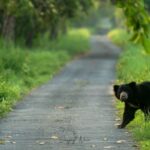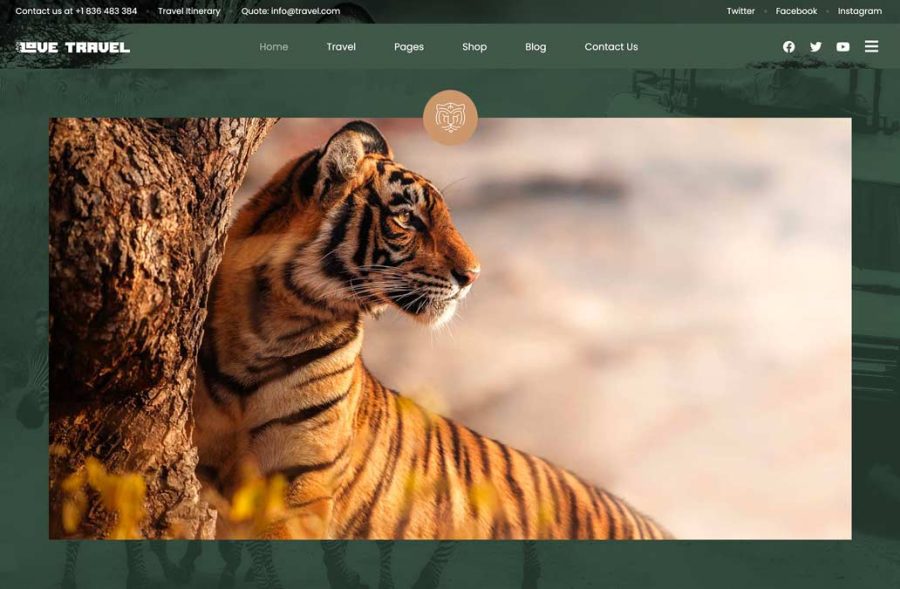Stepping into the wild on your first Wildlife safari in India feels like entering an ancient world, where nature commands your full attention and holds surprises at every turn. For many, India’s wildlife has an almost mythical allure, from the Bengal tiger’s amber-eyed stare to the soft padding of elephants on jungle paths.
But nature plays by its own rules, and a wildlife safari, especially a first one, is more fulfilling when you’re prepared, respectful, and open to the unexpected. With over a hundred parks and reserves across the country, each with its unique seasonal charms and wildlife, a few tips can make all the difference.
Whether you’re chasing tiger tracks in the dense jungles of Central India or observing migratory birds in the misty wetlands of the south, here are 5 tips (and 2 bonus tips) to enhance your experience on your first safari adventure.
Tip #1 – Choose the Right Season for the Wildlife Safari in India
India’s diverse seasons add layers to your wildlife safari experience. From the life-giving monsoons to the crisp winters and the vibrant summers, each season paints a distinct picture of the wild.
Understanding the seasonal rhythms of India’s wild spaces is key to planning a memorable safari. Each season brings unique experiences to the landscape, and knowing what to expect can shape your safari’s success.
Summer, which spans from March to June, is often considered the best time for tiger sightings as the rising temperatures draw animals to water sources.
However, with temperatures often reaching upwards of 40 degrees Celsius, the heat can be intense. For those willing to brave the warmth, the chance to see tigers lounging near rivers and waterholes is higher than at any other time of year.
In winter, from November to February, wildlife is equally active, with the added perk of more comfortable temperatures and extended safari hours. The cool mornings and evenings in parks across India are ideal for observing big cats, especially as this period overlaps with the tiger’s mating season.
However, winters in these regions can be surprisingly cold, with temperatures occasionally dropping close to freezing, so dressing in layers is a must.
In contrast, monsoon rains (July to September) bring a verdant burst to the forests, though some parks close during these months to allow wildlife time to thrive undisturbed. Parks like Jim Corbett, Tadoba & Sundarbans remain open year round. A little research about your chosen park and its seasonal wildlife habits will go a long way in setting the right expectations.
Tip #2 – Pack Essentials to Stay Comfortable during your wildlife safari in india
Packing for a wildlife safari in India isn’t just about having the right gear; it’s about being prepared for the nuances of India’s wilderness. The landscapes vary widely across the country, from the dry, dusty plains of Ranthambore to the lush, humid jungles of Periyar, and each environment brings its own challenges.
Neutral-colored clothing that blends into the environment is best, as it minimizes disruption to the animals and keeps you camouflaged. Light, breathable fabrics work well for summer, while winter safaris call for layers to adapt to temperature changes as the day progresses.
A sturdy hat, sunglasses, and sunscreen are essentials, as the sun can be harsh, especially on open-air Jeep safaris. Comfortable shoes are a must, even if you won’t be walking much, as bumpy rides on dirt tracks can be tough on your feet.
Binoculars and a good camera, ideally with a zoom lens, can enhance your experience by allowing you to observe animals without disturbing them. Many parks, especially in remote areas, have limited access to electronic payments, so carrying small cash reserves is helpful for tips or unexpected expenses.
Even if the safari operator provides snacks and water, bringing extra can be a lifesaver during long hours under the sun. And lastly, don’t underestimate the utility of a good insect repellent—Indian forests, particularly in humid areas, can have an abundance of mosquitoes and other insects.

Wildlife safari in India with Safari Lab
Best National Parks in India
Ranthambhore Roars: Ranthambhore National Park, with its ancient ruins, provides a backdrop to the majestic presence of Bengal tigers. Thrilling encounters and a rich historical legacy await.
Jim Corbett Tiger Reserve: Explore Jim Corbett National Park, the oldest in India, known for its diverse flora and fauna. From the Himalayan foothills to the banks of the Ramganga River, immerse yourself in the legacy of Jim Corbett.
Tadoba Tiger Reserve: Discover Tadoba, known for its rich biodiversity and tiger sightings. The landscape is a mix of rugged cliffs, marshes, and bamboo forests, offering a unique setting for wildlife enthusiasts.
Nagzira Tiger Reserve: Nagzira, a hidden gem, is characterized by lush greenery and pristine landscapes. It’s an ideal destination for birdwatchers, with numerous avian species gracing the skies.
Pilibhit Tiger Reserve: Pilibhit, nestled in the Terai region, is a haven for wildlife. The diverse ecosystem, including dense forests and grasslands, provides a habitat for a variety of species, including the majestic tiger.
Pench Tiger Reserve: Pench, with its teak-dominated forests and meandering rivers, inspired Rudyard Kipling’s ‘The Jungle Book.’ It’s renowned for its tiger population and offers a picturesque setting for wildlife enthusiasts.
Tip #3 – Embrace Silence and Patience: The Secrets to Spotting Wildlife
On a safari, nature often reveals itself to those willing to wait, observe, and listen. The sounds of the jungle—the rustling leaves, the distant calls of deer, or the sudden flap of a bird’s wings—become vital clues in the search for wildlife.
One of the most effective yet often overlooked strategies on safari is maintaining a respectful silence. Experienced guides rely on these natural sounds, such as animal alarm calls, to locate predators like tigers or leopards.
Each species has its own alarm call that signals a predator’s approach, and the tension in these moments is palpable. Staying quiet helps not only to respect the animals’ space but also to create a more immersive experience for everyone in the safari vehicle. Patience, too, is a virtue in the wild.
Unlike a zoo visit, where animals are on display, a safari requires you to remain open to the unpredictability of nature. You may wait an hour in one spot, watching a deer cautiously approach a waterhole, only to be rewarded with the sudden appearance of a tiger.
The thrill of these sightings comes not from speed but from quiet anticipation, making each encounter feel like a shared secret with the jungle.
Tip #4 – Look Beyond Tigers: The Full Spectrum of Wildlife Awaits
While tigers may be the most coveted sighting, India’s forests are teeming with incredible biodiversity that’s equally worth your attention. Many first-time visitors enter the jungle with a singular focus on big cats, but this approach can sometimes lead to disappointment.
Tigers are elusive, and even in parks known for high tiger densities, sightings aren’t guaranteed.
Instead, consider the safari a chance to discover the broader ecosystem. India’s parks are home to leopards, sloth bears, and wild dogs, each as fascinating as the tiger in their own way. Deer species like the elegant sambar or the delicate spotted chital are commonly sighted and often provide a captivating study of animal behavior as they navigate the landscape.
The birdlife, especially in winter when migratory species arrive, is a hidden gem, with everything from vibrant kingfishers to the grand Indian hornbill adding color to the forest canopy.
By embracing the diversity of the forest, from the smallest insect to the largest predator, you allow yourself to experience the true magic of an Indian safari.
Each species plays a role in the complex web of life, and observing them in their natural habitat offers insights into the delicate balance of these ecosystems.

Tip #5 – Hire a Trusted Safari Operator
The quality of your safari experience often hinges on the expertise of your safari tour operator.
For a first-time visitor, this experience can transform the safari, turning a simple drive through the forest into an insightful journey.
Look for operators who understand the landscape, are updated with the most recent sighting index and respect park regulations, keeping a respectful distance and avoiding loud or disruptive behavior.
Such companies often work closely with local communities and park authorities, helping to create sustainable tourism that benefits both wildlife and people. They also emphasize on knowledgable guides, like we do, at Safari Lab.
Please remember, that a knowledgeable guide does more than just navigate the forest; they interpret the language of the jungle, sharing stories, pointing out animal tracks, and explaining the interconnectedness of the ecosystem.
It’s worth spending some time researching reviews or getting recommendations for trusted wildlife tour operators who can add value to your safari.
Bonus Tip #1 – Book in Advance to Secure the Best Safari Gates
Planning ahead is one of the smartest strategies for maximizing your first wildlife safari in India. Each park has specific entry gates that provide access to different zones, and securing permits at the best gates can significantly enhance your chances of wildlife sightings.
For example, in popular parks like Jim Corbett, Dhikala zone and in Ranthambore, Zones 1-4 are often considered the premium safari areas, known for high tiger activity and ideal landscapes for sightings.
However, these zones are in high demand and limited in availability, with a fixed number of vehicles allowed each day. Booking your permits well in advance gives you a better chance of entering these sought-after areas.
By booking ahead, you’ll have more control over your safari experience and can choose gates and times that align with peak animal activity. Popular parks can become fully booked months in advance, especially during peak seasons like summer, when wildlife sightings are at their best, so securing your place early is essential.
For instance, Tadoba, Kanha, Bandhavgarh, Pench and Corbett can sell out months in advance. This preparation can make the difference between a crowded safari and an intimate encounter with India’s magnificent wilderness.
Bonus Tip #2 – Try Smaller and Lesser-Known Parks for a Unique Safari Experience
While India’s popular parks like Kanha, Bandhavgarh, and Ranthambore are renowned for their tiger populations and well-established safari infrastructure, the lesser-known parks often offer hidden treasures and unique, less crowded experiences.
Parks such as Satpura in Madhya Pradesh, Dudhwa in Uttar Pradesh, and Nagzira in Maharashtra provide diverse landscapes and rare wildlife without the bustling crowds that accompany more famous reserves.
In these parks, the quieter ambiance allows for more intimate wildlife encounters, and the diversity of species goes beyond big cats, showcasing everything from Indian bison, Dhole, Rhinos and sloth bears to rare bird species and rich plant life.
Opting for a wildlife safari in india in a lesser-known park can also bring the opportunity to experience different safari styles, such as walking safaris, which are offered in Kaziranga & Periyar. These types of safaris provide a more immersive experience, connecting you to the forest in a way that vehicles simply cannot.
Smaller parks often work closely with local communities and naturalists who possess invaluable knowledge of the local flora and fauna, creating a more personal safari experience.
While sightings of big cats may be less predictable in some of these parks, they make up for it with the richness of other wildlife and the unique perspective they offer.
Exploring beyond the well-known parks expands your understanding of India’s ecosystems, offering an equally captivating journey into the wild with the added allure of discovering hidden gems.
Conclusion
A wildlife safari in India isn’t simply a journey to see animals; it’s an immersive experience that takes you into the heart of nature, where every sound, sight, and scent has a story. By approaching the adventure with respect, curiosity, and an open mind, your first safari can become a treasured memory, filled with the thrill of discovery.
Each tip here is designed to help you step into the wilderness not just as an observer but as part of an ancient landscape, where patience, awareness, and respect for the natural world reveal the true magic of the jungle.
So pack well, stay curious, and embrace each moment as it comes—the wild is waiting for you.
Share Your Experience during your wildlife safari in india
We invite you to share your first safari experiences, favorite wildlife sightings, or any questions you may have. Join our community and connect with fellow wildlife enthusiasts.
Follow Safari Lab on our social media platforms for further engagement, tips, and updates. Your safari journey has just begun, and we’re excited to be part of it.
Embark on your first wildlife safari in India with these tips, and let the magic of the wild unfold before your eyes. Happy safari-ing!



























